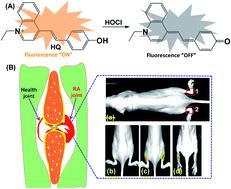Our official English website, www.x-mol.net, welcomes your feedback! (Note: you will need to create a separate account there.)
Quinoline-based fluorescent probe for the detection and monitoring of hypochlorous acid in a rheumatoid arthritis model
RSC Advances ( IF 3.9 ) Pub Date : 2021-09-24 , DOI: 10.1039/d1ra06224g Xinyi Yang 1 , Yue Wang 1 , Zhuye Shang 1 , Zexi Zhang 2 , Haijun Chi 3 , Zhiqiang Zhang 3 , Run Zhang 2 , Qingtao Meng 1
RSC Advances ( IF 3.9 ) Pub Date : 2021-09-24 , DOI: 10.1039/d1ra06224g Xinyi Yang 1 , Yue Wang 1 , Zhuye Shang 1 , Zexi Zhang 2 , Haijun Chi 3 , Zhiqiang Zhang 3 , Run Zhang 2 , Qingtao Meng 1
Affiliation

|
The development of effective bioanalytical methods for the visualization of hypochlorous acid (HOCl) in situ in rheumatoid arthritis (RA) directly contributes to better understanding the roles of HOCl in this disease. In this work, a new quinoline-based fluorescence probe (HQ) has been developed for the detection and visualization of a HOCl-mediated inflammatory response in a RA model. HQ possesses a donor–π–acceptor (D–π–A) structure that was designed by conjugating p-hydroxybenzaldehyde (electron donor) and 1-ethyl-4-methylquinolinium iodide (electron acceptor) through a C![[double bond, length as m-dash]](https://www.rsc.org/images/entities/char_e001.gif) C double bond. In the presence of HOCl, oxidation of phenol to benzoquinone led to the red-shift (93 nm) of the adsorption and intense quenching of the fluorescence emission. The proposed response reaction mechanism was verified by high performance liquid chromatography (HPLC) and high-resolution mass spectroscopy (HRMS) titration analysis. The remarkable color changes of the HQ solution from pale yellow to pink enabled the application of HQ-stained chromatography plates for the “naked-eye” detection of HOCl in real-world water samples. HQ featured high selectivity and sensitivity (6.5 nM), fast response time (<25 s) to HOCl, reliability at different pH (3.0 to 11.5) and low cytotoxicity. HQ's application in biological systems was then demonstrated by the monitoring of HOCl-mediated treatment response to RA. This work thus provided a new tool for the detection and imaging of HOCl in inflammatory disorders.
C double bond. In the presence of HOCl, oxidation of phenol to benzoquinone led to the red-shift (93 nm) of the adsorption and intense quenching of the fluorescence emission. The proposed response reaction mechanism was verified by high performance liquid chromatography (HPLC) and high-resolution mass spectroscopy (HRMS) titration analysis. The remarkable color changes of the HQ solution from pale yellow to pink enabled the application of HQ-stained chromatography plates for the “naked-eye” detection of HOCl in real-world water samples. HQ featured high selectivity and sensitivity (6.5 nM), fast response time (<25 s) to HOCl, reliability at different pH (3.0 to 11.5) and low cytotoxicity. HQ's application in biological systems was then demonstrated by the monitoring of HOCl-mediated treatment response to RA. This work thus provided a new tool for the detection and imaging of HOCl in inflammatory disorders.
中文翻译:

基于喹啉的荧光探针检测和监测类风湿关节炎模型中的次氯酸
开发用于在类风湿性关节炎 (RA)中原位显示次氯酸 (HOCl) 的有效生物分析方法直接有助于更好地了解次氯酸在该疾病中的作用。在这项工作中,开发了一种新的基于喹啉的荧光探针 ( HQ ),用于检测和可视化 RA 模型中的 HOCl 介导的炎症反应。HQ具有供体-π-受体 (D-π-A) 结构,该结构是由对羟基苯甲醛(电子供体)和 1-乙基-4-甲基碘化喹啉(电子受体)通过 C 共轭设计的![[双键,长度为 m-dash]](https://www.rsc.org/images/entities/char_e001.gif) C双键。在 HOCl 存在下,苯酚氧化为苯醌导致吸附红移 (93 nm) 和荧光发射的强烈猝灭。通过高效液相色谱 (HPLC) 和高分辨率质谱 (HRMS) 滴定分析验证了所提出的反应反应机制。HQ溶液从淡黄色到粉红色的显着颜色变化使HQ染色色谱板能够应用于真实水样中的 HOCl 的“肉眼”检测。HQ具有高选择性和灵敏度 (6.5 nM)、对 HOCl 的快速响应时间 (<25 s)、在不同 pH 值(3.0 至 11.5)下的可靠性和低细胞毒性。总部然后通过监测 HOCl 介导的对 RA 的治疗反应来证明其在生物系统中的应用。因此,这项工作为炎症性疾病中 HOCl 的检测和成像提供了一种新工具。
C双键。在 HOCl 存在下,苯酚氧化为苯醌导致吸附红移 (93 nm) 和荧光发射的强烈猝灭。通过高效液相色谱 (HPLC) 和高分辨率质谱 (HRMS) 滴定分析验证了所提出的反应反应机制。HQ溶液从淡黄色到粉红色的显着颜色变化使HQ染色色谱板能够应用于真实水样中的 HOCl 的“肉眼”检测。HQ具有高选择性和灵敏度 (6.5 nM)、对 HOCl 的快速响应时间 (<25 s)、在不同 pH 值(3.0 至 11.5)下的可靠性和低细胞毒性。总部然后通过监测 HOCl 介导的对 RA 的治疗反应来证明其在生物系统中的应用。因此,这项工作为炎症性疾病中 HOCl 的检测和成像提供了一种新工具。
更新日期:2021-09-24
![[double bond, length as m-dash]](https://www.rsc.org/images/entities/char_e001.gif) C double bond. In the presence of HOCl, oxidation of phenol to benzoquinone led to the red-shift (93 nm) of the adsorption and intense quenching of the fluorescence emission. The proposed response reaction mechanism was verified by high performance liquid chromatography (HPLC) and high-resolution mass spectroscopy (HRMS) titration analysis. The remarkable color changes of the HQ solution from pale yellow to pink enabled the application of HQ-stained chromatography plates for the “naked-eye” detection of HOCl in real-world water samples. HQ featured high selectivity and sensitivity (6.5 nM), fast response time (<25 s) to HOCl, reliability at different pH (3.0 to 11.5) and low cytotoxicity. HQ's application in biological systems was then demonstrated by the monitoring of HOCl-mediated treatment response to RA. This work thus provided a new tool for the detection and imaging of HOCl in inflammatory disorders.
C double bond. In the presence of HOCl, oxidation of phenol to benzoquinone led to the red-shift (93 nm) of the adsorption and intense quenching of the fluorescence emission. The proposed response reaction mechanism was verified by high performance liquid chromatography (HPLC) and high-resolution mass spectroscopy (HRMS) titration analysis. The remarkable color changes of the HQ solution from pale yellow to pink enabled the application of HQ-stained chromatography plates for the “naked-eye” detection of HOCl in real-world water samples. HQ featured high selectivity and sensitivity (6.5 nM), fast response time (<25 s) to HOCl, reliability at different pH (3.0 to 11.5) and low cytotoxicity. HQ's application in biological systems was then demonstrated by the monitoring of HOCl-mediated treatment response to RA. This work thus provided a new tool for the detection and imaging of HOCl in inflammatory disorders.
中文翻译:

基于喹啉的荧光探针检测和监测类风湿关节炎模型中的次氯酸
开发用于在类风湿性关节炎 (RA)中原位显示次氯酸 (HOCl) 的有效生物分析方法直接有助于更好地了解次氯酸在该疾病中的作用。在这项工作中,开发了一种新的基于喹啉的荧光探针 ( HQ ),用于检测和可视化 RA 模型中的 HOCl 介导的炎症反应。HQ具有供体-π-受体 (D-π-A) 结构,该结构是由对羟基苯甲醛(电子供体)和 1-乙基-4-甲基碘化喹啉(电子受体)通过 C 共轭设计的
![[双键,长度为 m-dash]](https://www.rsc.org/images/entities/char_e001.gif) C双键。在 HOCl 存在下,苯酚氧化为苯醌导致吸附红移 (93 nm) 和荧光发射的强烈猝灭。通过高效液相色谱 (HPLC) 和高分辨率质谱 (HRMS) 滴定分析验证了所提出的反应反应机制。HQ溶液从淡黄色到粉红色的显着颜色变化使HQ染色色谱板能够应用于真实水样中的 HOCl 的“肉眼”检测。HQ具有高选择性和灵敏度 (6.5 nM)、对 HOCl 的快速响应时间 (<25 s)、在不同 pH 值(3.0 至 11.5)下的可靠性和低细胞毒性。总部然后通过监测 HOCl 介导的对 RA 的治疗反应来证明其在生物系统中的应用。因此,这项工作为炎症性疾病中 HOCl 的检测和成像提供了一种新工具。
C双键。在 HOCl 存在下,苯酚氧化为苯醌导致吸附红移 (93 nm) 和荧光发射的强烈猝灭。通过高效液相色谱 (HPLC) 和高分辨率质谱 (HRMS) 滴定分析验证了所提出的反应反应机制。HQ溶液从淡黄色到粉红色的显着颜色变化使HQ染色色谱板能够应用于真实水样中的 HOCl 的“肉眼”检测。HQ具有高选择性和灵敏度 (6.5 nM)、对 HOCl 的快速响应时间 (<25 s)、在不同 pH 值(3.0 至 11.5)下的可靠性和低细胞毒性。总部然后通过监测 HOCl 介导的对 RA 的治疗反应来证明其在生物系统中的应用。因此,这项工作为炎症性疾病中 HOCl 的检测和成像提供了一种新工具。


























 京公网安备 11010802027423号
京公网安备 11010802027423号